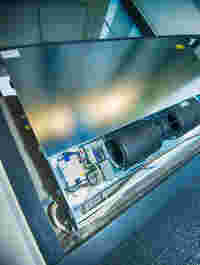Reboot on Kapstadtring Street
At the end of the 1960s, the “City Nord” development project in Hamburg included the German headquarters of Esso. However, thanks to the economic boom in West Germany, the city center was soon bursting at the seams, which drove the decision to relocate large corporations. The building on Kapstadtring in Winterhude, a district in northern Hamburg, was designed by the Hamburg architectural firm Schramm and Pempelfort. Soon, after complete internal renovations, it will reopen as a modern office and administration building. The WAGO-I/O-SYSTEM 750 is an important technical cornerstone that ensures the 47,000 square meters of usable space can be easily adapted to employees’ needs.
Hamburg’s City Nord development demonstrates that new ways of working, due primarily to the introduction of computerized workstations, have largely rendered open-plan offices obsolete. This attitude change in the 1990s hurt the image of City Nord. The building complex, designed by renowned architects of the time, failed to keep up with the times in terms of function and technology. Over the course of the City Nord revitalization, the open-plan office gave way to individual offices, which were created through renovation of existing buildings, new projects and demolitions.
The Energy Transition Goes Digital – Here’s How WAGO Supports You:
- WAGO’s controllers ensure secure communication and control.
- The new VHReady communication standard facilitates the interplay of decentralized systems.
- Data encryption and specially secured connections defend against unauthorized access.
